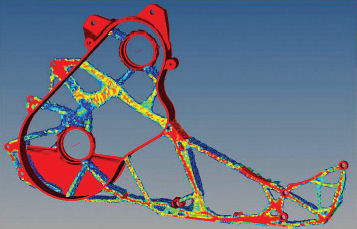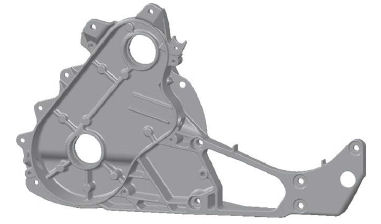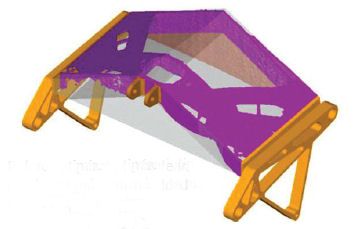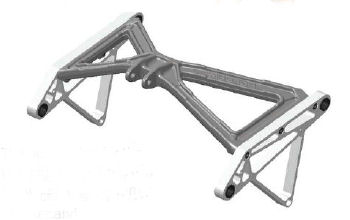
By optimizing the chain case and bulkhead, Polaris was able to save 0.2 pounds and increase stiffness.
Latest News
January 1, 2015
For snowmobilers, there’s nothing like the thrill of freshly fallen snow. The same could be said for Polaris, a leading snowmobile manufacturer that is blazing new trails with optimization technology to get lighter, high-performance sleds out to market well ahead of its competition.
 By optimizing the chain case and bulkhead, Polaris was able to save 0.2 pounds and increase stiffness.
By optimizing the chain case and bulkhead, Polaris was able to save 0.2 pounds and increase stiffness.Identifying opportunities for alternative materials and lighter weight components isn’t exactly a novel development charter for Polaris or any other manufacturer of high-performance equipment, be it a car or a recreational vehicle. While streamlining designs to be more lightweight without sacrificing structural integrity has always been the goal, there have been numerous obstacles along the way, including a need for hours of specialized simulation work and dozens of protracted design iterations.
 This new design removes several joint structure and fasteners, creating a single part chain case.
This new design removes several joint structure and fasteners, creating a single part chain case.“The biggest challenge for us in terms of lightweighting is that this is a very fast-paced industry, not only because of product timelines, but because it’s a very seasonal business,” says Luc Wilson, senior design engineer for Polaris’ Snowmobile group. Going at the problem the old-fashioned way means Polaris engineers create a model of a design, run it through finite element analysis (FEA) tools to identify areas of low stress, redesign those areas to reduce material composition, do another round of FEA and repeat the process many times, before landing on the optimal design.
“Depending on the level of complexity, we go through a couple of dozen iterations,” Wilson says. “The process is just too time consuming and resource consuming.”
Eliminating the Guesswork
In 2012, Polaris engineers got a lead on technology that could help break the lightweighting design bottleneck. Optimization technology, employed early in the development cycle, showed potential for helping the team zero in on possible areas for material reduction or shape redesign well before putting 3D models through their paces with FEA simulation as part of the validation process. The team began experimenting with Altair’s OptiStruct topology optimization solver, and later with the more user-friendly solidThinking Inspire concept generation tool, to arrive at lightweight designs faster.
Enlisting optimization methods upfront eliminates a lot of the guesswork when developing new snowmobile concepts, says Wilson. That’s important when you’re trying to finesse next-generation snowmobile platforms against a rigorous time-to-market schedule—typically three to four years from concept to production.
“Knowing where to add materials and where you can reduce material definitely streamlines the process from design to first prototype,” he says. “By taking a bunch of those iterations out of the timeline, you can be more efficient with the time you have.”
Polaris’ first experiment with optimization came a couple of years back in the early planning stages for its AXYS 2015 snowmobile platform, the first trail performance models to undergo a major weight reduction effort. Polaris’ goal for the AXYS platform was to offer an extremely lightweight vehicle that didn’t compromise ride and handling or durability—a design approach that encompassed everything from reducing the number of parts to substituting steel components with lighter weight aluminum structures where and when it made sense.
OptiStruct’s first target for weight loss was the snowmobile chassis. The team created an amorphous design space or package, as it is called in OptiStruct, to which it applied the appropriate load conditions. The software’s topology analysis capabilities identified possible areas for material reduction. The process yielded a new, lighter design that combined the central chain case and bulkhead side casting into a single assembly, eliminating a joint structure and fasteners. By reducing the number of parts and through other design modifications, the optimization exercise shaved 0.2 pound off the weight of the 2014 multi-piece snowmobile assembly while increasing stiffness—a combination key to accelerating performance of the new AXYS 2015 platform.
“OptiStruct generated a structure that we probably wouldn’t have thought of using traditional methods,” Wilson says. “We might have gotten there eventually, but it wouldn’t have been obvious and it would have required more costly prototypes.”
The rear crank assembly was another area where optimization technology made its mark. The suspension structure, originally made out of heavy, welded steel components, was recast in lightweight aluminum with a forged center piece and extruded side pieces thanks to an optimization-inspired design alternative that trimmed 2.7 pounds off the original assembly. Based on those successes, the Polaris team moved forward to leverage OptiStruct and solidThinking Inspire in several other key areas, including the “X brace” for the rear chassis, which ended up as a “K” to allow for more room for fuel, and in the chain case’s lower sprocket, which was revamped to eliminate a series of holes while still achieving a weight savings of 0.64 pound, Wilson says.
In total, Polaris was able to eliminate over 30 pounds from the AXYS 2015 platform compared to the previous generation Polaris Pro-Ride platform. By optimizing and getting the design right early in the process, Polaris’ engineering team also minimized the likelihood of major issues popping up during the validation stage. “When you’re doing more iterations the old way, you may or may not get a design that works the way you wanted it to by the first validation season,” he explains. “The sooner you have things locked down and finalized, the more likely the rest of the process is smooth sailing.”
Not a Magic Bullet
One way Polaris is promoting the use of optimization is by taking advantage of more accessible tools like Altair’s solidThinking Inspire, which has a look and feel similiar to familiar CAD applications, Wilson says. “Inspire makes it even easier and takes even more time out of the process because it can be picked up easily by someone who doesn’t have a huge background in CAE or FEA,” he explains. “Inspire helps design engineers and [CAD] designers pick up and explore and put a different perspective on what they are trying to achieve.”
 Before optimization, the rear crank was made with welded steel components.
Before optimization, the rear crank was made with welded steel components.While optimization provides a much-needed boost to the design cycle, Wilson cautions that the tools are not a panacea, and they still require a lot of engineering know-how and finesse in order to zero in on the optimal lightweight design. For example, the optimization tool doesn’t specify which material to use nor does it output a fully featured design. “It doesn’t give you a fully baked solution—a lot of time, the shapes are organic and you have to figure out how to take that shape and make it manufacturable,” Wilson says. “Also, if you start with incorrect loads or your constraints aren’t correct, you may come up with a solution, but it might not be accurate or correct.”
 The new design for the rear crank is 2.7 pounds lighter and made from aluminum.
The new design for the rear crank is 2.7 pounds lighter and made from aluminum.Wilson also stresses that optimization is not a replacement for FEA, but rather can have a significant impact in the upfront process by identifying an optimized structure that can be further validated with FEA analysis. To avoid over-reliance on the optimization results, Wilson suggests conducting peer reviews to provide a sanity check as design alternatives are identified by the tool.
“Now that optimization has proven itself to be effective, we will start to apply it to more areas of the vehicle and try to expand our knowledge to other Polaris groups that can benefit from the technology,” Wilson says.
More Info
Subscribe to our FREE magazine, FREE email newsletters or both!
Latest News
About the Author
Beth Stackpole is a contributing editor to Digital Engineering. Send e-mail about this article to [email protected].
Follow DE





